Sell directly to your customers how and where they want.
What Is Social Commerce? Impact, Examples & Trends in 2024
This article is part of a larger series on Retail Management.
Social commerce refers to the buying and selling of products on social platforms. Product research, discovery, and purchase are done in-app and without ever leaving a social channel. Social commerce removes friction from a customer’s buying experience, creates a more engaging environment, and generates opportunities to increase consumer interest.
In this article, we discuss the impact of social commerce in the retail and ecommerce landscape, the top social platforms, trends, and best practices to know, and successful brands that leveraged social commerce for their business.
Key Takeaways:
- Social commerce lets you go where the people are, and sell to them. It’s a win-win situation that retailers should embrace and leverage.
- Selling on social needs research, strategy, and creative thinking. Focus on the platform where your target audience is, and build your marketing and selling strategy from there.
- AR technology, livestream shopping, short-form videos, and micro-influencers are social commerce trends brands need to watch out for this year.
Social Commerce Overview
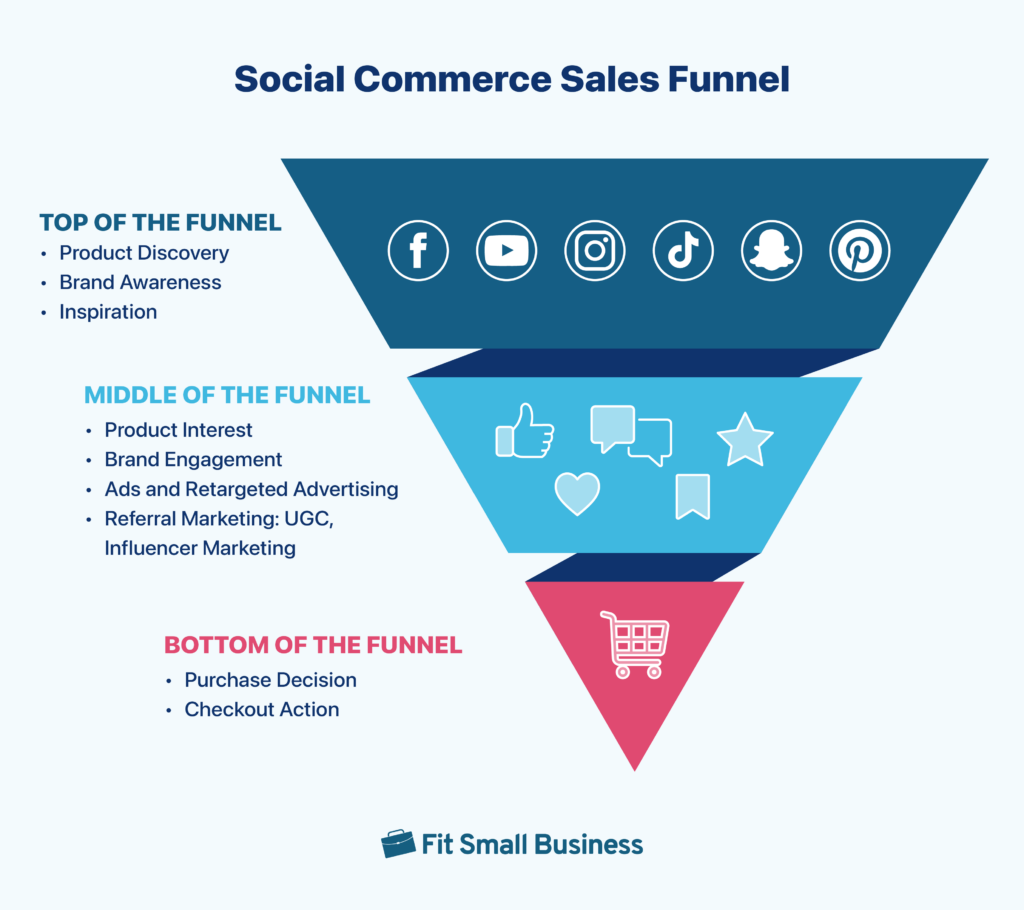
Not only does social commerce create a frictionless purchasing experience for a consumer, but it also provides an enhanced shopping journey. In social commerce, consumers can discover products, get personalized recommendations based on scrolling habits and preferences, and engage with related communities, gaining real-time feedback and advice from other social media users.
Social commerce also shifts the power of purchasing influence from brands to people (fellow consumers). Unlike ecommerce, where consumers shop with a product in mind, social commerce excels at promotion and delivery of entertaining content, powered by community engagement (by influencers and creators).
Since social commerce sparks product discovery, generating product demand is achieved through virality and promotion. Product promotion in social media happens differently, with consumers relying on user-generated content (UGC), influencer recommendations, and product virality rather than brand-sponsored posts.
Consumers can go from browsing their feeds to making a purchase in seconds. And since they are in a trusted platform, there are minimal blockers. Social commerce then becomes a seamless experience for shoppers.
However, take note that social commerce is not:
- Social media marketing. In social media marketing, shoppers view a brand’s content in social channels and visit the brand’s website to start shopping. When you talk about social commerce, the social channels act as virtual storefronts—shopping is done in-app.
- Social selling. Social commerce is confused often with social selling. Social selling refers to the process of relationship building with a goal to close a sale. It can happen in person or online, but often happens through social media.
Social Commerce: Impact on Ecommerce
Social commerce is more than an online shopping trend—it’s a response to the evolution of consumer behavior. Social commerce is becoming mainstream because of the time consumers spend on social media. EMARKETER forecasts that US adults will spend nearly 18% of their digital media time with social platforms in 2024.
Since social commerce merges social media with ecommerce, direct purchases made within social platforms have risen. Social commerce sales took up roughly 5.9% of ecommerce sales in the US in 2022. This was projected to increase, with 106.8 million US social buyers and social commerce sales at $64.8 billion forecast in 2023.
US social commerce is projected to reach close to $150 billion by 2028, while globally, social commerce is estimated to reach about $2.9 trillion by 2026. Even social spending per US buyer is set to increase, nearly doubling from $627.8 in 2023 to $1,223.7 in 2027, according to EMARKETER’s forecast.
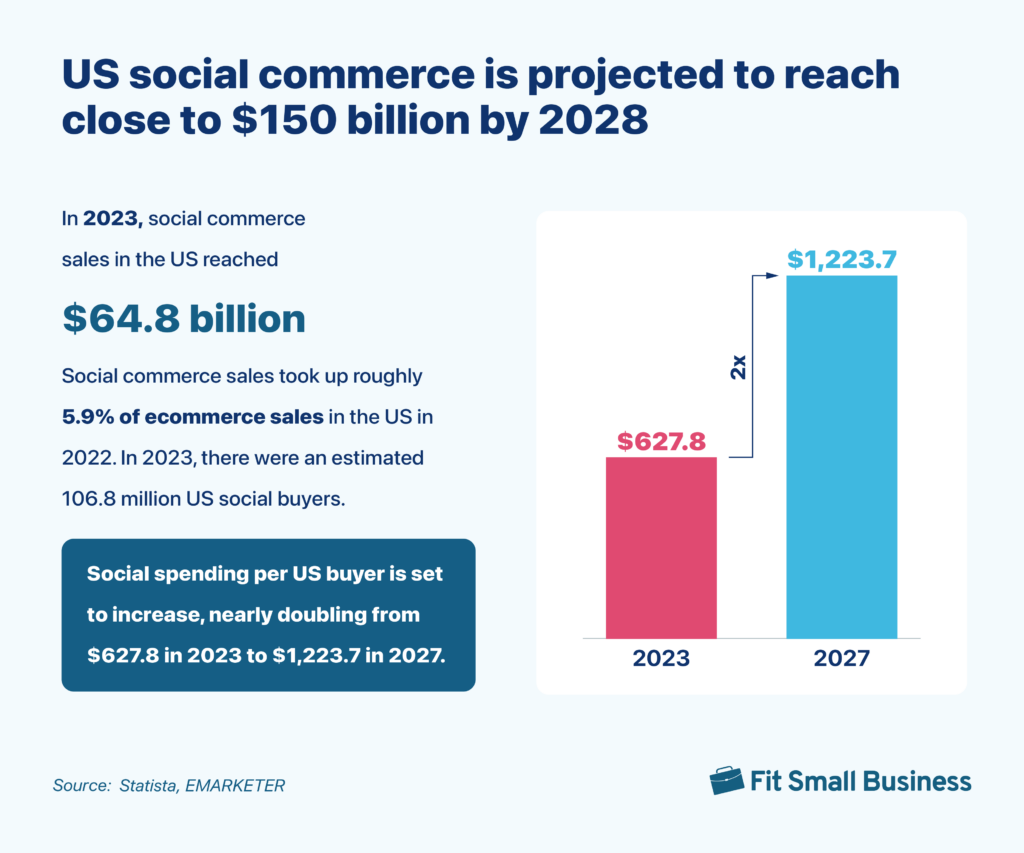
Social Commerce vs Ecommerce
Selling on social media and ecommerce both involve online selling but are not the same. They differ on selling platforms, engagement, content control, and customer data access.
Social Commerce | Ecommerce | |
|---|---|---|
Online Store | Social channels (Facebook, Instagram, TikTok, Snapchat, Pinterest) | Ecommerce platform (A full-blown standalone store) |
Traffic Generators | Authentic & entertaining content, UGC, and influencer marketing | SEO and paid advertising |
Customer Data | Depends on platform | Has access |
Engagement | Real time | Limited |
Content control & limitations | Obligated to follow the platform’s rules and regulations | Full control over website content |
When you talk about ecommerce, it is an online shopping experience that takes place on a website or an app. Ecommerce stores are built on ecommerce platforms. When you talk about social commerce, the online shopping experience takes place on social platforms. Users scroll content, discover products, and check out without ever leaving the app.
You don’t have to have an ecommerce site when you decide to sell on social platforms. But, online merchants that have ecommerce stores can benefit from selling on social media and directing leads from their social accounts to their websites too.
Social commerce is easy to set up with little to no overhead or setup costs, but technically, you are limited to the social platform’s rules about content posting. Also, depending on the platform, you may have limited to no access to shoppers’ data, which can be challenging for customer retention strategies. All these are easily accomplished with your own online store.
Top Social Commerce Platforms
Among social channels, Facebook, Instagram and Pinterest were the first to introduce in-app shopping capabilities. YouTube and Snapchat followed suit, with TikTok officially launching its TikTok Shop in the US in 2023.
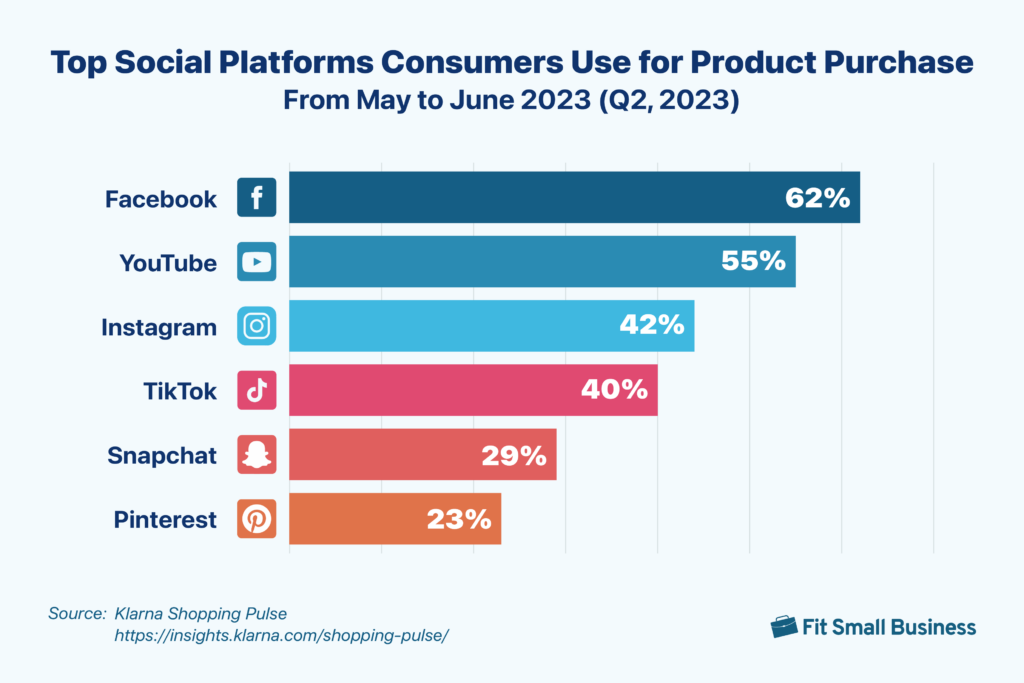
1. Facebook
Facebook still tops the list with the largest number of social commerce buyers, with the platform’s buyers expected to reach 64.6 million in 2024. Brands can sell through Facebook Shops once they create a Facebook page, while one-off sellers can join brands on Facebook Marketplace, a social marketplace for buying and selling secondhand items. Marketplace is the primary reason Facebook has such a strong lead in social commerce.
Key Stats:
- Facebook has 272 million monthly active users in the US and Canada as of the fourth quarter of 2023
- 54.9% of Facebook users follow or research brands and products on the platform
Unlike the community selling nature of Facebook Marketplace, Facebook Shops lets businesses set up digital storefronts, where consumers can explore and buy products without leaving the platform. Facebook Shops provides product catalogs that allow brands to create better visuals and detailed product descriptions. Brands can showcase new or seasonal products and launches, promotions, and offerings.
Learn more:
- Selling on Facebook Shops & Facebook Marketplace
- How to Create a Facebook Business Page
- Marketing Strategies for Facebook Pages
- Facebook Ads Cost: Stats, Trends & Return on Spend
- How to Set Up a Shopify Facebook Store
2. Instagram
Instagram, like Facebook, is under Meta. A more visual platform than Facebook, it was only natural for Instagram to introduce the shopping experience to its users. Instagram lets consumers buy products shown in images and videos across the app (shoppable posts) and like Facebook, those with business accounts can showcase their products through a virtual storefront in the app.
Key Stats:
- Instagram will see 46.8 million US social buyers in 2024
- 44% of Instagram users shop weekly on the platform
- 1 in 2 people use Instagram to discover new brands
There are many ways small businesses can use Instagram Shops to sell their products. Those under a business account can use shopping tags in their feed posts and Stories, add a shop tab to their profile, and establish a Shop through direct messaging (DMs).
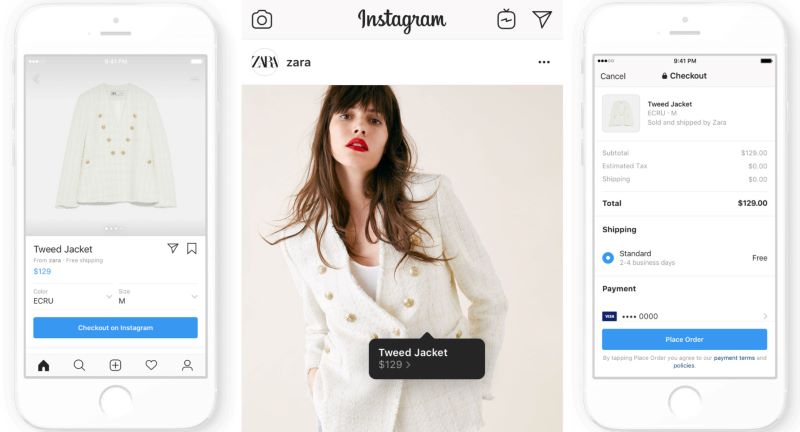
(Source: TechCrunch)
Learn more: How to Sell on Instagram: Steps + Tips
3. YouTube
YouTube is the second-largest search engine, with more than 2.5 billion active users per month and over 1 billion hours of video watched on the platform each day. According to Klarna data, 55% of US consumers made a purchase on the platform during the second quarter of 2023.
Key Stats:
- 89% of YouTube viewers trust the recommendations YouTube creators provide
- YouTube is a big player in social commerce among Gen Xers (64%) and millennials (63%)
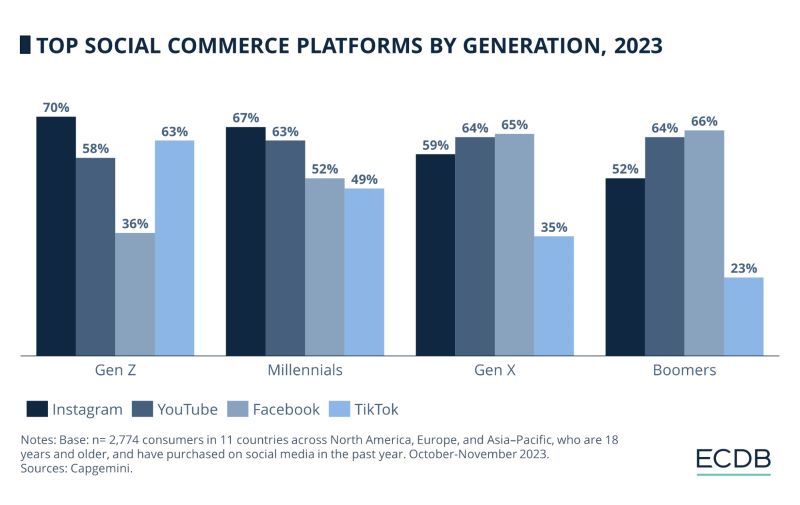
(Source: ECDB)
YouTube recognizes how the social platform can be further enhanced by ecommerce, so it collaborated with Shopify to allow merchants to showcase their products in videos, introduced the timestamps feature for pinpointing shopping opportunities within content, and provided tools for bulk tagging of affiliate products across video libraries.
4. TikTok
TikTok has taken the whole world by storm—it’s the highest-earning app that’s not a mobile game today ($10 billion global consumer spending). TikTok combines entertainment, community, education, and shopping in its platform, and as a result, is emerging as a threat to ecommerce giants like Amazon. Small businesses are shifting their focus on the social platform to sell online as consumers are using the platform more and more.
Key Stats:
- TikTok has approximately 1.9 billion users worldwide
- TikTok has 150 million users in the US as of March 2023
- 2 out of 3 TikTok users are likely to buy something while on the platform
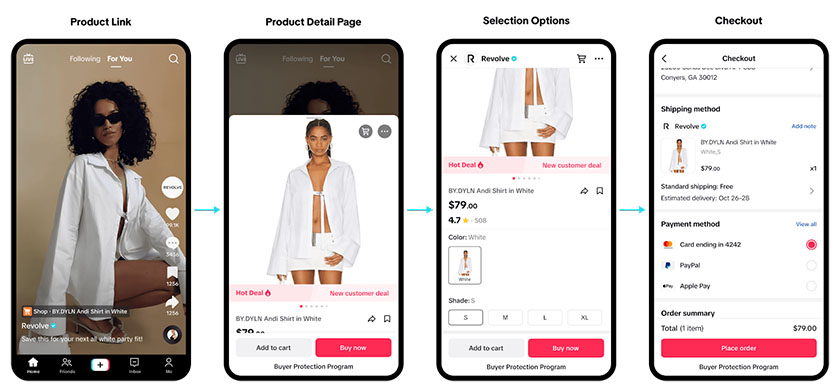
TikTok Shop has shoppable videos allowing consumers to directly add products to their cart and checkout without leaving the app.
Merchants that have an online store with Shopify can integrate their store into the platform. With the launch of TikTok Shop in the US, small businesses can set up their stores directly on TikTok. TikTok relies heavily on entertaining and authentic videos. Virality is the name of the game. And while Meta has pulled back on livestream shopping, TikTok is doubling down on it. Half of TikTok users have bought something after watching a TikTok LIVE.
Learn more:
- How to Sell on TikTok
- 25 TikTok Products to Sell
- TikTok Ecommerce Strategy Guide
- How to Create a TikTok Marketing Strategy
- TikTok Shop Statistics
5. Pinterest
Pinterest is a visual discovery engine that enables its users (called Pinners) to discover, explore, and share their interests, ideas, and inspirations by pinning (posting) images and videos. Pinterest’s audience is “ready to buy”—85% say Pinterest is where they go to start a new project.
Key Stats:
- In 2022, Pinterest reported that 498 million people use the platform every month
- 50% of US Pinterest users use the platform for ecommerce
- 46% of weekly users have discovered a new brand or product on Pinterest
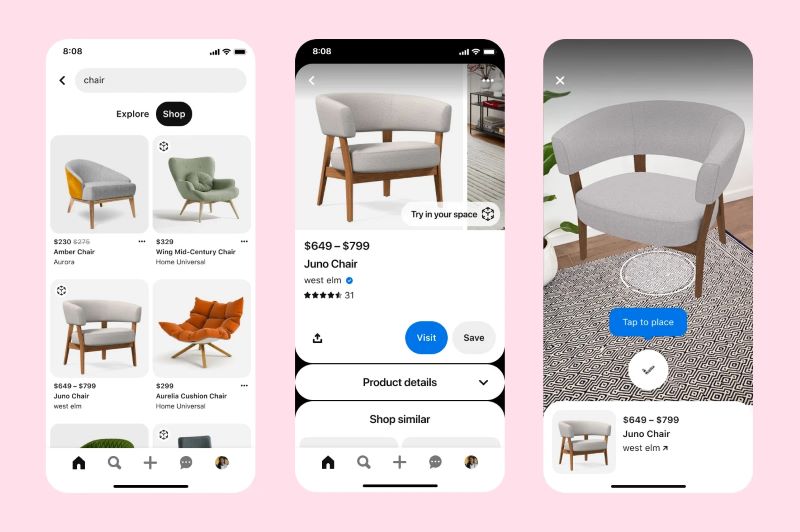
In 2022, Pinterest introduced Try On for Home Decor. It can virtually place items from US retailers like Crate & Barrel, CB2, Walmart, West Elm, and Wayfair in their home using the Pinterest Lens camera, and try before they buy using augmented reality.
In 2022, Pinterest released merchant tools, such as product tagging on Pins and a Pinterest API for Shopping. It also launched an AR-powered feature called Try On for Home Decor for virtual trying of furniture items from US retailers like Crate & Barrel, CB2, Walmart, West Elm, and Wayfair. Then in 2023, Pinterest started beta testing native checkout functionality to allow for in-app purchases in the US.
As of the moment, Pinterest Shopping is only available to select countries.
Learn more:
6. Snapchat
Launched in 2011 as a camera-first entertainment app, Snapchat has been heavily investing in augmented reality (AR) technology. In 2020, Snapchat launched a Shoppable AR technology to try a virtual try-on campaign with Gucci. The platform then invested on more social commerce technology in 2021, primarily with AR.
Key Stats:
- Snapchat has 750 million monthly active users in 2024
- 85.6% of Gen Z social network users use Snapchat
- 250 million Snapchat users have engaged with AR shopping lenses in 2022
Snapchat Shopping allows businesses to set up shoppable product catalogs and AR filters and lets customers place orders with each business without leaving the Snapchat app. AR remains a focus for Snapchat with Lenses being a central part of the purchasing process.
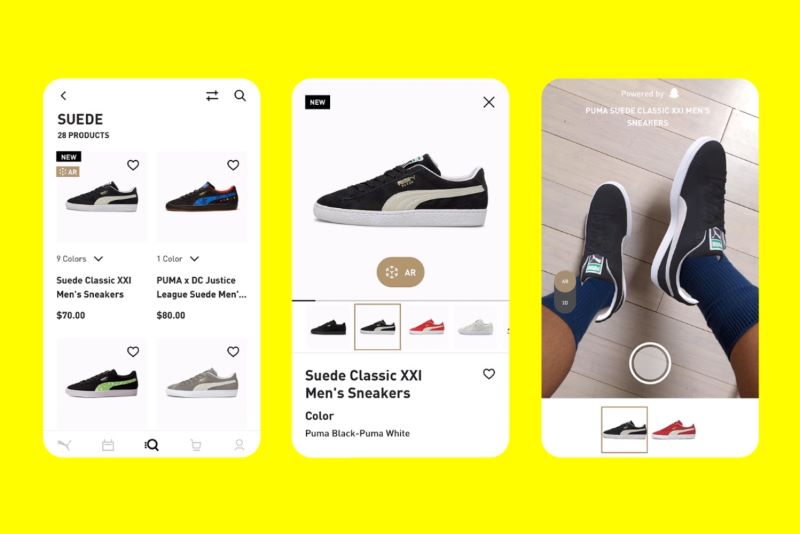
In 2022, Snapchat launched a dedicated space for shopping called ‘Dress Up.’ (Source: Campaign UK)
Related: Virtual Reality (VR) in Retail: Guide With Examples
Social Commerce Examples of Brands
Take a look at the brands who leveraged social commerce successfully.
David Outwear (Facebook)
Men’s clothing retailer David Outwear focuses on leather jackets, coats and accessories and actively promotes their products on Facebook by tagging them in their posts. Once a product catches a potential customer’s eye, it’s easy for them to click on the product page and see the price, then buy.
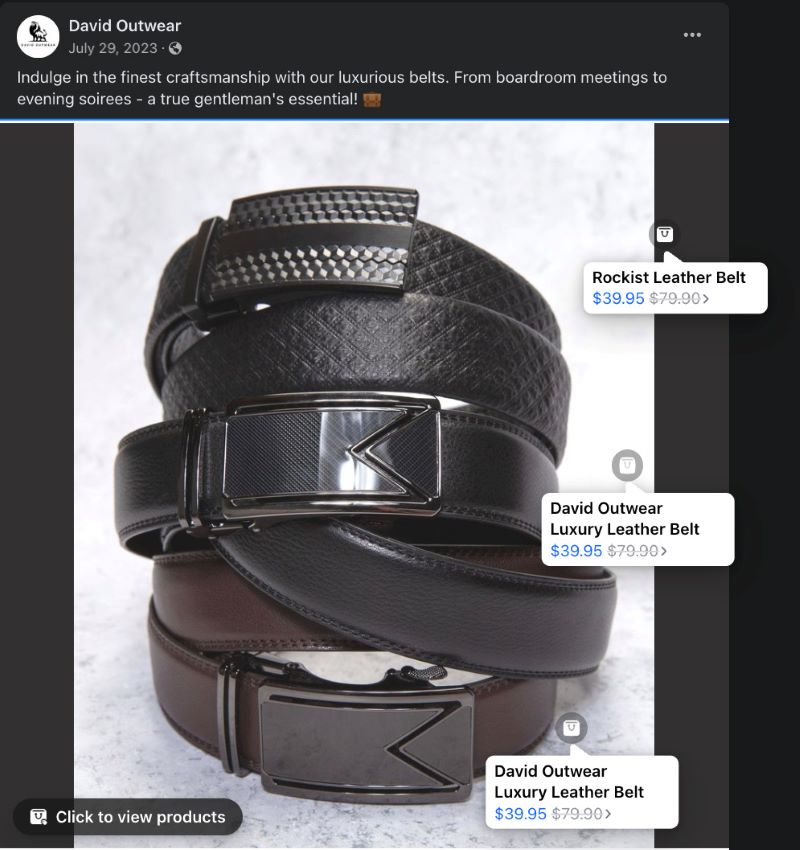
With Facebook, you can tag featured products even retroactively. Facebook recommends limiting tagging to less than five products per image or post.
Summer Fridays (Instagram)
Skincare brand Summer Fridays uses all available selling methods available on Instagram. They have set a Shop tab in the profile, uses Instagram shoppable posts and reels, and balances all product placements with lifestyle photos and helpful content.
Their Instagram shop is complete with a product catalog with individual product detail pages too.
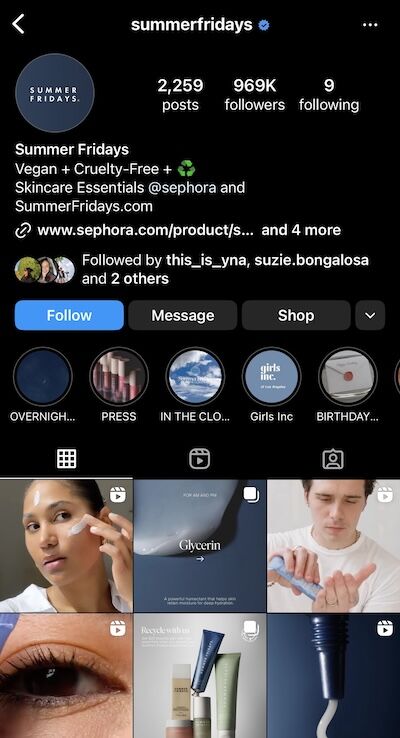
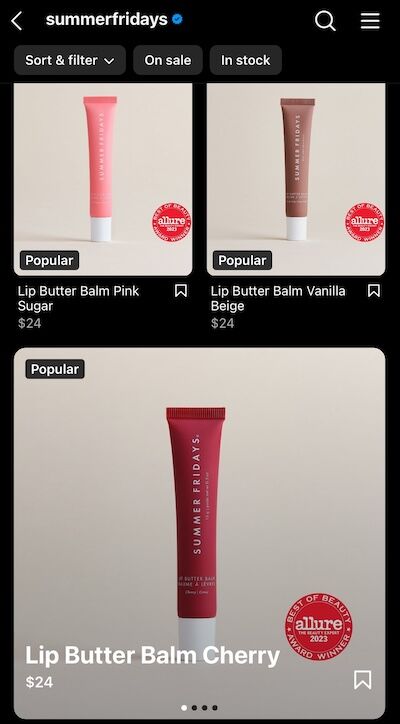

Lavendaire (Pinterest)
Lavendaire is a brand that sells journals and apparel with a Pinterest account that organically gets 3 million monthly views. Lavendaire shines in Pinterest by creating Idea Pins by showcasing how to use the company’s journaling products, with the products tagged and linked.
Enchanted Scrunch (TikTok)
Sasha Derkach started her business by promoting on TikTok after initially posting on Instagram. Her virality didn’t happen overnight. It took two months for a video to get 15k views and 10 orders in the first days.
As she focused on marketing on TikTok, around 90% of her overall sales are now made through the platform. She shares that once they started getting 100 orders a week, they did TikTok Lives daily and got almost 500 orders a week.
@enchantedscrunch Except I did and I am… #teenager #haterswillhate #shopping #hair #scrunchies #fypシ ♬ original sound – michelle 🧸
Social Commerce Best Practices
The social commerce industry registered $992 billion in global sales in 2022 and is expected to reach $8.5 trillion by 2030. As a small business owner, selling on social platforms has sure benefits such as increased brand awareness and sales.
However, ensuring you leverage social commerce in the right ways is crucial to success. Here are some of our recommended best practices to get started on social commerce:
- Sell where your target audience is. It can be tempting to sell on every social platform but it is actually counterproductive. Determine where your target market is most active (like TikTok for Gen Zers) and focus your marketing and selling efforts there.
- Lean into social proof. Encourage your buyers to leave product reviews on social media by posting their purchases. UGC can be in the form of hashtags, unboxing videos, how-to tutorials, and images of them using the product. People need to trust your brand before they buy, and online shopping statistics show that seven out of 10 shoppers are influenced by friends’ social media posts and reviews.
- Remember to post quality, engaging, and entertaining content. Social platforms are still primarily for entertainment and connection. Craft a social media strategy around your product offerings and be mindful not to post consecutive product posts in your feed.
- Engage with your followers. Social platforms are a great way to build relationships and engage with your customers to build community. You can get real-time feedback and recommendations, and you also can deliver fantastic support.
- Listen strategically. Stay on top of consumer pulse and trends. This helps you be flexible in your marketing and act swiftly on viral trends. You can leverage your promotions this way. You can also monitor your competition on social platforms and see how your brand is performing against them.
- Evaluate your data regularly. Social platforms give you traffic and engagement reports on a regular basis. Make sure to be consistent on checking your numbers so you can adjust your strategy accordingly once you see what is working and what isn’t.
Related:
- Social Media Marketing for Small Business: Guide + Template
- How to Make a Social Media Plan in 5 Steps [+ Free Template]
- Best Social Media Marketing Tools for Small Businesses
- Social Media Marketing Statistics to Power Your Strategy
- Ways to Use AI in Social Media (+ Examples)
Social Commerce Trends to Watch Out for in 2024
Stay ahead of the competition and tap into social commerce trends in 2024
- People engage with more AR experiences. Shoppers are embracing technology when shopping. Use AR technology offered by social platforms (like Lenses for Snapchat) to let shoppers try the products before they buy.
- Prioritize video content. Eighty-one percent of consumers want to see more short-form videos from brands this year, with Sprout Social saying the short-form videos deliver the highest form of return of investment (ROI) compared to other formats. Take note, though, that a healthy mix of content formats is essential to attract all consumers. Social apps are known to do crossover features—introduce a new feature based on the popularity of it in another platform (the same way Instagram introduced Reels in response to the virality of TikTok videos). For example, TikTok has introduced Notes, which is a feature for posting photos.
- Micro and nano-influencers go mainstream. With the rise of de-influencing came the increased consumer mistrust of influencers. Consumers want more authentic content and not just sponsored posts or brand collaborations. Enter micro-influencers—people with less than 50,000 followers and have niched postings but very high engagement rates. If you are wanting to tap into the world of influencer marketing, go with this type of influencer.
- Livestream shopping will increase in popularity. Livestream shopping combines live video and social commerce to boost sales. Almost all social platforms, particularly TikTok and YouTube, have been increasingly used to schedule livestream selling. Meta’s two platforms, Facebook and Instagram, have discontinued livestream shopping but most brands still use the platforms to go live and sell their products by way of commenting and manually processing orders.
Related:
- Top Ecommerce Trends
- Current Retail Trends Shaping the Industry in 2024
- Small Business Trends to Watch in 2024
- Livestream Shopping Statistics
Frequently Asked Questions (FAQs)
These are some of the commons we frequently encounter about social commerce.
Bottom Line
Social commerce should be embraced by brands and retailers. Social platforms provide new opportunities to enhance and introduce new shopping experiences, connect with consumers in more ways, and market differently.

